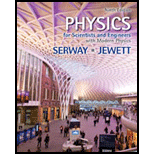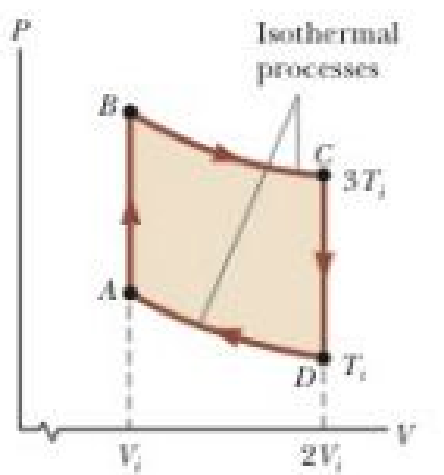
In 1816, Robert Stirling, a Scottish clergyman, patented the Stirling engine, which has found a wide variety of applications ever since, including current use in solar energy collectors to transform sunlight into electricity. Fuel is burned externally to warm one of the engine’s two cylinders. A fixed quantity of inert gas moves cyclically between the cylinders, expanding in the hot one and contracting in the cold one. Figure P21.33 represents a model for its thermodynamic cycle. Consider n moles of an ideal monatomic gas being taken once through the cycle, consisting of two isothermal processes at temperatures 3Ti and Ti and two constant-volume processes. Let us find the efficiency of this engine. (a) Find the energy transferred by heat into the gas during the isovolumetric process AB. (b) Find the energy transferred by heat into the gas during the isothermal process BC. (c) Find the energy transferred by heat into the gas during the isovolumetric process CD. (d) Find the energy transferred by heat into the gas during the isothermal process DA. (e) Identify which of the results from parts (a) through (d) are positive and evaluate the energy input to the engine by heat. (f) From the first law of

Trending nowThis is a popular solution!

Chapter 22 Solutions
Physics for Scientists and Engineers With Modern Physics
Additional Science Textbook Solutions
College Physics (10th Edition)
Physics: Principles with Applications
Fundamentals of Physics Extended
Matter and Interactions
Physical Science
Integrated Science
- Figure P21.36 shows a cyclic thermodynamic process ABCA for an ideal gas. a. What is the net energy transferred into the system by heat during each cycle? b. What would be the net energy transferred into the system by heat if the cycle followed the path ACBA instead? FIGURE P21.36 FIGURE P21.37arrow_forwardFigure P22.73 illustrates the cycle ABCA for a 2.00-mol sample of an ideal diatomic gas, where the process CA is a reversible isothermal expansion. What is a. the net work done by the gas during one cycle? b. How much energy is added to the gas by heat during one cycle? c. How much energy is exhausted from the gas by heat during one cycle? d. What is the efficiency of the cycle? e. What would be the efficiency of a Carnot engine operated between the temperatures at points A and B during each cycle?arrow_forwardA thermodynamic cycle is shown in Figure P21.34 for a gas in a piston. The system changes states along the path ABCA. a. What is the total work done by the gas during this cycle? b. How much heat is transferred? Does heat flow into or out of the system? Figure P21.34arrow_forward
 Physics for Scientists and Engineers with Modern ...PhysicsISBN:9781337553292Author:Raymond A. Serway, John W. JewettPublisher:Cengage Learning
Physics for Scientists and Engineers with Modern ...PhysicsISBN:9781337553292Author:Raymond A. Serway, John W. JewettPublisher:Cengage Learning Principles of Physics: A Calculus-Based TextPhysicsISBN:9781133104261Author:Raymond A. Serway, John W. JewettPublisher:Cengage Learning
Principles of Physics: A Calculus-Based TextPhysicsISBN:9781133104261Author:Raymond A. Serway, John W. JewettPublisher:Cengage Learning Physics for Scientists and Engineers: Foundations...PhysicsISBN:9781133939146Author:Katz, Debora M.Publisher:Cengage Learning
Physics for Scientists and Engineers: Foundations...PhysicsISBN:9781133939146Author:Katz, Debora M.Publisher:Cengage Learning


